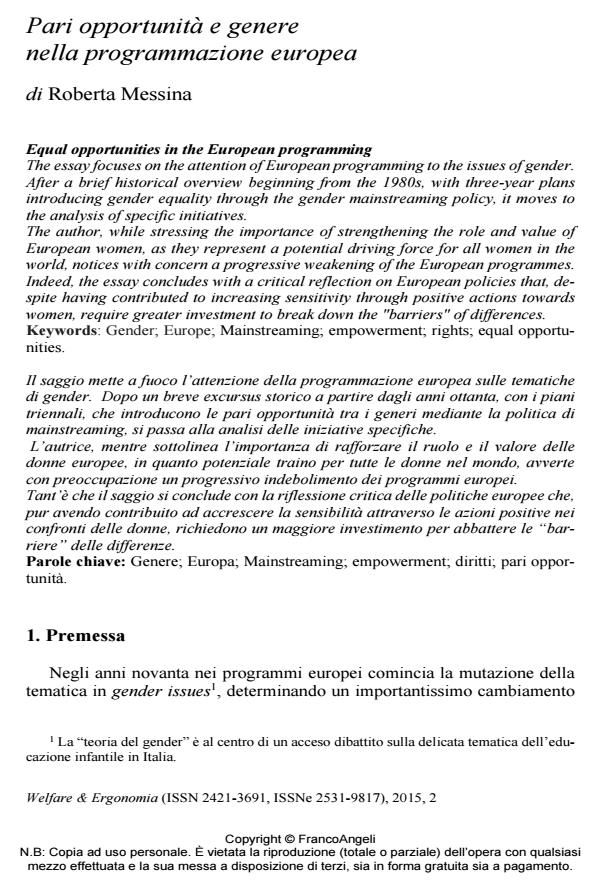Equal opportunities in the European programming
Journal title WELFARE E ERGONOMIA
Author/s Roberta Messina
Publishing Year 2017 Issue 2015/2
Language Italian Pages 13 P. 27-39 File size 248 KB
DOI 10.3280/WE2015-002003
DOI is like a bar code for intellectual property: to have more infomation
click here
Below, you can see the article first page
If you want to buy this article in PDF format, you can do it, following the instructions to buy download credits

FrancoAngeli is member of Publishers International Linking Association, Inc (PILA), a not-for-profit association which run the CrossRef service enabling links to and from online scholarly content.
The essay focuses on the attention of European programming to the issues of gender. After a brief historical overview beginning from the 1980s, with three-year plans introducing gender equality through the gender mainstreaming policy, it moves to the analysis of specific initiatives. The author, while stressing the importance of strengthening the role and value of European women, as they represent a potential driving force for all women in the world, notices with concern a progressive weakening of the European programmes. Indeed, the essay concludes with a critical reflection on European policies that, despite having contributed to increasing sensitivity through positive actions towards women, require greater investment to break down the "barriers" of differences.
Keywords: Gender; Europe; Mainstreaming; empowerment; rights; equal opportunities
- Aagaard Nielsen K., Svensson L. G., eds. (2006). Action research and interactive research – beyond practice and theory. Maastricht: Shaker.
- Acker J. (1999). Gender and organisation. In: Saltzman C. J., ed., Handbook of the sociology of gender. New York: Plenum.
- Caporossi P. (2009). Il corpo di Diotima. La passione filosofica e la libertà femminile. Macerata: Quodlibet.
- Carayannis E. G., Campbell D. F. J. (2012). Triple Helix, Quadruple Helix and Quintuple Helix and how do knowledge, innovation and the environment relate to each other? A proposed framework for a trans-disciplinary analysis of sustainable development and social ecology. Journal of the Knowledge Economy, Springer Link, 3(1): 25-35.
- Commissione europea (2014). EaSI. Nuovo programma ombrello comunitario per l’occupazione e la politica sociale. L’Europa Sociale. Bruxelles: Unione europea.
- Danilda I., Lindberg M., Torstensson B.-M. (2009). Women resource centres – a Quattro Helix innovation system on the European agenda. Paper presented at Triple Helix vii (Glasgow, uk, 17-19 June 2009).
- Duby G., Perrot M. (1991). Storia delle donne in Occidente. Roma-Bari: Laterza.
- Irigaray L. (1975). Speculum. L’altra donna. Milano: Feltrinelli (ed. or. 1974).
- Messina R. (1998). Ricette per il Mainstreaming. Palermo: La Luna.
- Muraro L. (2006). L’ordine simbolico della madre. Roma: Editori Riuniti (ii ed.).
- Unità tematica C – Direzione Generale delle politiche interne (2014). La Politica per l’uguaglianza di genere in Italia. Bruxelles: Parlamento europeo.
Roberta Messina, Pari opportunità e genere nella programmazione europea in "WELFARE E ERGONOMIA" 2/2015, pp 27-39, DOI: 10.3280/WE2015-002003